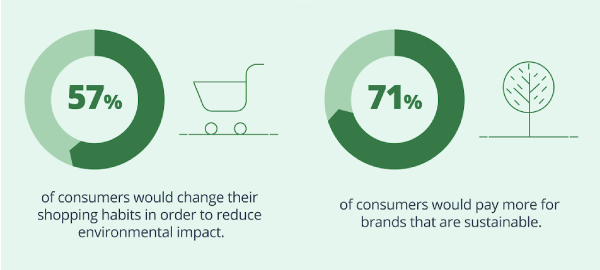
Local council to insist on contractor mental health checks
Construction Enquirer report that Halton Borough Council is now insisting that all main contractors bidding to win work from it have to “include a scored

If you’re running a small business, then you might think your environmental impact is inconsequential. But the people buying your products don’t see it that way.
Faced with compounding environmental crises, consumers are starting to vote green with their wallets. Businesses of all shapes and sizes need to continually analyse consumer sentiment because as people learn more about climate change and its effects, they are changing their buying habits.
In a survey by U.S. shipping service Sendle, 57 percent of responders said climate change had somewhat or fully caused them to reassess their purchasing habits, and nearly 71 percent said they had set goals to purchase more sustainable products in 2020.
And sustainability is an important issue for consumers of all age groups, with at least 75 percent saying it is moderately to extremely important to them.

Consumers are more apt to shop with sustainable brands, and will alter how they shop to reduce environmental impact.
So clearly, what’s good for the planet is also good for small-business customers.
The first thing businesses need to do on their journey to becoming more sustainable is to understand their current carbon footprint. Having this information will help identify the areas where changes will have the most impact.
Each business has its own particularities, so the steps one company takes won’t necessarily be the same as the steps others may take. Here are several ways for small businesses to reduce their environmental impact.
As more work gets done online, there is less need for people to be in a physical office. Remote work has taken off over the past few years, allowing employees to have work-life flexibility and substantially reducing their time spent commuting.
This is great for the environment. Fewer cars on the road, idling in traffic, equates to less carbon dioxide (CO2) being emitted into the air.
This small change can help reduce traffic and a business’s overall carbon footprint. Further, with fewer people in the office, companies can save money usually spent stocking, lighting and heating the workplace.
When employees do need to be in the office, how their commute contributes to greenhouse gas emissions still can be influenced.
Public transportation (buses, trains,) is the greenest way to commute, and companies can encourage employees to take advantage of these transport options.
Small businesses can provide employees with public transit benefits that help the environment, either directly or through their human resources (HR) software.
To provide these benefits directly, many city transit agencies offer subsidised passes for businesses. Alternately, these benefits may be available to add through HR software that centralises all benefit programs.
The items companies purchase to ensure their workplaces function well — be it printer paper, cleaning products or to-go containers — can be deleterious to the environment due to the processes that go into making them.
For all those paper items commonly used, such as rolls of toilet paper and reams of printer paper, office managers can look for labelling that says it is made from post- or pre-consumer waste. Recycled products such as these maintain a circular economy and reduce overall waste.
For cleaning products, there is a whole cottage industry of green cleaners that don’t include toxic chemicals, opting instead for natural ingredients that work just as well. Using these products keeps toxic ingredients out of the streams and their waste out of landfills.
Decking out the office doesn’t have to mean paying top dollar for brand-new furniture.
It takes a lot of energy and raw material to make all those new tables, chairs, couches and desks. Companies can go the green route instead by finding beautiful vintage pieces to fill out their offices or opting for recycled furniture.
This ensures that fully functional furniture won’t be tossed into landfills in favour of the newest styles. Who wouldn’t want some incredible mid-century furniture in their office?
The best way to keep waste out of landfills is by never sending it there in the first place.
The order of the Rs is important. First, companies should endeavour to reduce usage where they can. Instead of disposable cups, plates and utensils (not to mention coffee pods), they can opt for real glass and ceramic alternatives.
Reuse items whenever possible. In the warehouse, instead of throwing out structurally intact boxes, they can go another round. In the office, employees should be encouraged to use both sides of the printer paper.
When reducing or reusing aren’t possible, recycling is the next best thing. Many cities helpfully provide bins for this and have made the recycling process less complicated, so it’s much easier to leave the trash can entirely empty these days.
Another way to divert waste from landfills is to compost. An increasing number of cities are capable of composting just about any organic matter.
The difference between that banana peel in the compost and that banana peel in the dump is what it becomes. In the dump, it slowly decays and off-gases methane, a much more destructive greenhouse gas. In the compost, it decays quickly and becomes soil for gardens and parks.
The workplace is a perfect place to implement a compost program. All those lunch leftovers can be turned into soil instead of methane.

For businesses that sell and ship products, packaging is a major part of the operation. From the packaging that each unit is sold in to the mailers and boxes they are eventually shipped out in, this material adds up quickly.
A survey done created by a shipping service found that 64 percent of consumers would be more likely to make a purchase from a retailer that offered compostable packaging (especially if it didn’t cost more).
Recycled paper and cardboard are tried and true sustainable packaging options, but there have also been strides toward creating completely compostable packaging that results in zero waste at the end of its cycle.
Becoming energy efficient doesn’t only help to shrink carbon footprints, it also helps to reduce a company’s energy bill.
Many simple things can be done: use energy-efficient appliances; move to LED lights; automate lights with sensors; use smart thermostats; take advantage of natural light; and supply staff with laptops instead of desktop computers.
Saving money and saving the planet are not mutually exclusive.
Websites use energy, too. The servers that host a website’s data are constantly on, using up copious amounts of energy.
Luckily, companies can choose where their data is stored. More and more, eco-conscious companies are offsetting that energy usage to go carbon neutral.
Google has done a lot to decarbonise its data centres and claims that its cloud services produce zero net carbon emissions. And the largest cloud computing provider out there, Amazon, has promised to achieve the same by 2040 through wind and solar farms.
Web hosting isn’t the only way businesses can go carbon-neutral with the companies they choose to operate with.
From software companies and food and beverage brands to apparel labels and shipping carriers, carbon-neutral vendors can be found across every major industry. For many small businesses, their supply chain also will have a big impact on their own footprint.
Again, becoming a sustainable business depends on the companies they support.
Finally, for whatever portion of a company’s carbon footprint that can’t be reduced through changes, the purchase of offsets can move the needle to carbon neutrality.
Businesses can use a variety of carbon marketplaces to both calculate and offset their emissions. When choosing, it’s important to search for third-party certification and the projects the investments are made in.
Every company has a different level of impact on the planet, but as a whole, we all contribute to climate change, pollution and the waste crisis.
Each company’s journey to becoming environmentally sustainable will be unique but it’s more critical than ever to start now and get it right.
At a time when even the biggest companies — including McDonald’s, Microsoft and Samsung — are incorporating sustainability practices into their businesses, it’s obvious that the climate crisis is a very dire phenomenon.
And every business has their part to play, whatever their size. By taking account of our individual carbon footprints and taking the steps to shrink them down, we can help slow and hopefully reverse the effects of climate change.

Construction Enquirer report that Halton Borough Council is now insisting that all main contractors bidding to win work from it have to “include a scored

DNV UK’s Business Assurance team, alongside training partner, Temple, hosted their latest ‘Centre of Excellence’ event earlier this month at Cranmore Park in Shirley. This

Redefining Intelligence: The Growth of AI Among Small Firms, highlights that while AI excels at recognising patterns at speeds that dwarf human capabilities, it falls

The Chancellor has today (4 March) announced a significant investment package in the UK’s life sciences and manufacturing sectors. £92 million joint government and industry